Journal of Electromagnetic Analysis and Applications
Vol.5 No.3(2013), Article ID:29216,3 pages DOI:10.4236/jemaa.2013.53021
Time Domain of Sommerfelds Problem of Lossy Half-Space
![]()
1Department of Mathematics, Faculty of Science, University of Kafr el-Sheikh, Kafr el-Sheikh, Egypt; 2Department of Physics, Faculty of Science for Girls, King Abdulaziz University, Jeddah, KSA.
Email: falseroury@gmail.com
Received November 30th, 2012; revised December 29th, 2012; accepted January 14th, 2013
Keywords: Vertical Dipole; Electromagnetic Field; Wave Equation
ABSTRACT
This paper solved the problem of the scattering of radiation from a material half-space by the transient spectral domain method. The transient spectral domain method is a general theoretical approach for the exact solution to the time-dependent source radiation in the presence of media. It is located in the air region in the vicinity of lossy half-space. The apply of the integral transform to the wave equation in the horizontal coordinates in space by a two-dimensional Fourier transform is theoretical formulation of the problem. A source used is an electrically short vertical magnetic dipole with Impulse current distribution in the domain. Leads, under consideration of initial boundary and transition condition, the form expressions is achieved in terms of spectral domain variable and time. The integral representation determines the electromagnetic field anywhere the closed-form expressions is an achieved in terms of spectral domain variable and time.
1. Introduction
Historically, time domain solution of Sommerfeld problem can be used in different areas of electromagnetics, such as evaluation of remoto-sensing systems for detection of shallow buried objects (Wait [1]). In this paper the classical time domain problem formed by vertically oriented magnetic dipole with impulsive current density distribution in front of lossy half-space is studied theoretically. The exact solution of such problem was obtained by Sommerfeld [2] for vertical dipole source radiation have two dielectric half space. Weyl [3] and Banons [4] studied from a vertical electric dipole situated at a certain height h above a plane earth all field quantities are usually assumed to vary harmonically in time the classical time domain problem formed by vertically oriented magnetic dipole with impulsive current density distribution in forint of lossy half space is studied theoretically (Sommerfeld half space problem).
One of the two well-known methods for solving this steady-state problem is due is Sommerfeld [2], the other to Weyl [3].
Today, interest is mainly concerned with the effect of the atmosphere on target identification and imaging. An accurate and efficient method for computing Sommerfeld integrals is crucial in the analysis of electromagnetic field due to radiators and scatters embedded in layered media.
In several recent publications, however, the case is considered where the time dependence of the current in the dipole is impulsive rather than harmonic e.g. the studies by Banos [4]; Lindell and Alanen [5] and Dvorak and Mechaik [6], these techniques can be grouped in the following categories; quasi-analytical solutions which include asymptotic approximations series expansions and image representations, direct numerical integration, and methods which use numerical techniques.
In the present paper it is shown that Cagniard’s method can be simplified considerably if the corresponding modification for two-dimensional problems as developed by the present author. Cagniard’s [7] the modified Cagniard mothed is used to derive closed form expressions for the Hertizen vector anywhere above the duct and Cagniard idea is applica ble as it is based on source. It is closed related to a similar method developed by Caginard, who, too, was concerned with the generation of seismic wave by impulse source and their technique originating from an impulsive wave propagation is electric media is taken a guidance the theoretical study for computing the magnetic field from a Fizragld vector in the ionosphere is presented Abo-seliem [8,9]. Two integral transforms are applied to analyze a Laplace transform in time and twodimensional Fourier transforms in the horizontal coordinate in the space is applied for the Hertizan vector in the wave equation. This leads to an integral representation of the wave equation in the free space.
2. Formulation of the Problem
As Figure 1 shown, a plane interface separates two regions 1, 2, region 1 is considered as free 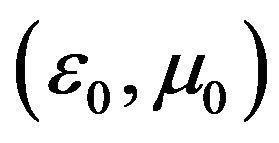 space and region 2
space and region 2 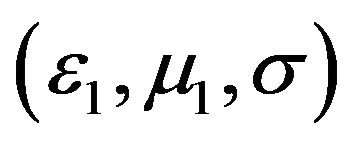 a lossy half-space the source is located in region 1. Assuming homogenous isotropic and linear medium in each region, we may write the Maxwell equations as Stratton [10]
a lossy half-space the source is located in region 1. Assuming homogenous isotropic and linear medium in each region, we may write the Maxwell equations as Stratton [10]
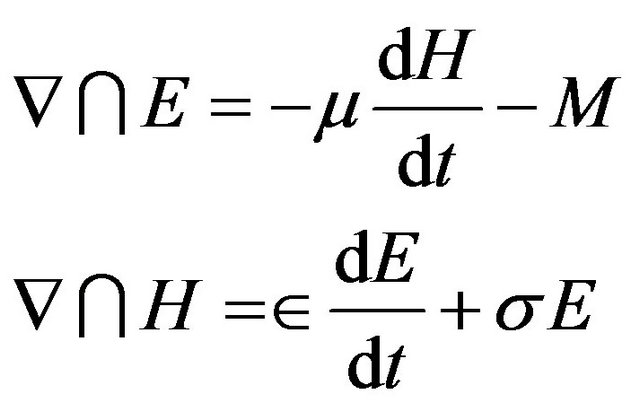 (1)
(1)
where M is intrinsic magnetic current density in the medium.
The solution of this problem is facilitated by introducing the electric potential F, as below:
 (2)
(2)
where F satisfies the homogenous vector Helmholtz equations
 (3)
(3)
 (4)
(4)
The magnetic current density 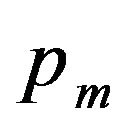 is assumed to have only a z-component with impulse distribution in time and be located in lossless half-space (region 1) as shown in Figure 1.
is assumed to have only a z-component with impulse distribution in time and be located in lossless half-space (region 1) as shown in Figure 1.
By assuming a z-component for the electric vector potential  and
and  is the intrinsic magnetic current density, we can write the above wave equation a,
is the intrinsic magnetic current density, we can write the above wave equation a,
 (5)
(5)
 (6)
(6)
Equations (1) and (2) the definition of electric vector
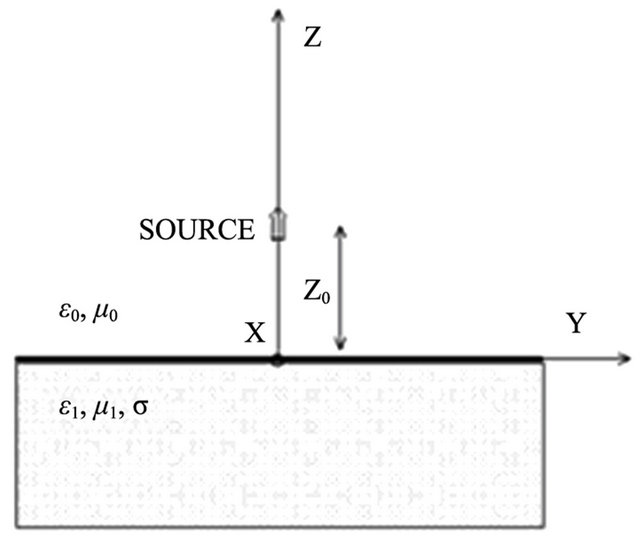
Figure 1. Geometry of the problem.
potential (3) ad nibs the form of electromagnetic field in terms of F.
 (7)
(7)
For the electric field and magnetic field
 (8)
(8)
 (9)
(9)
 (10)
(10)
By the two dimensional Fourier transform with respect to x and y, the solution of (6) and (7) can be expressed in terms of cylindrical wave that have the some radial wave number in air and within the lossy half-space.
 (11)
(11)
Then
 (12)
(12)
 (13)
(13)
The exact solution of (12) and (13) are
 (14)
(14)
where
 (15)
(15)
 (16)
(16)
where
 (17)
(17)
(14) and (16) are obtained for homogenous radiation with 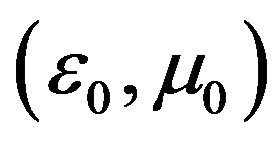 and
and 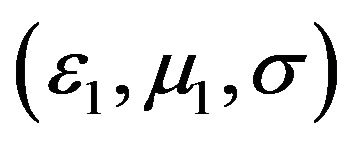 respectively.
respectively.
We use the concept of the primary and scattered wave in the spherical that is for z
 (18)
(18)
where
 (19)
(19)
 (20)
(20)
where 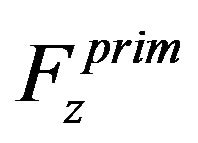 denotes the incident field primary wave in the absence of the general and represents the scattered wave due presence of the ground in special domain in z we have
denotes the incident field primary wave in the absence of the general and represents the scattered wave due presence of the ground in special domain in z we have
 (21)
(21)
where (18), (19) and (21) are expressed in terms of the some radial wave number, which is paper for boundary condition satisfaction. The continuity of tangential electric and magnetic fields at general interface can be used to find the unknown coefficients R and T.
 (22)
(22)
 (23)
(23)
Substituting (18), (19) and (21) in the above equations, we have and at 
 (24)
(24)
 (25)
(25)
where
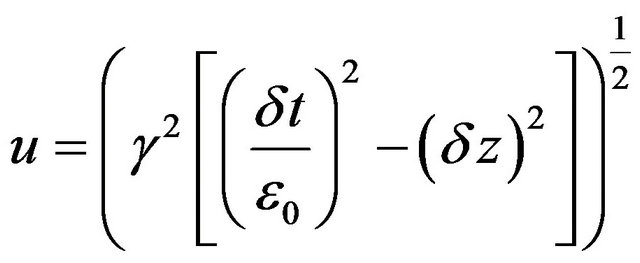 (26)
(26)
 (27)
(27)
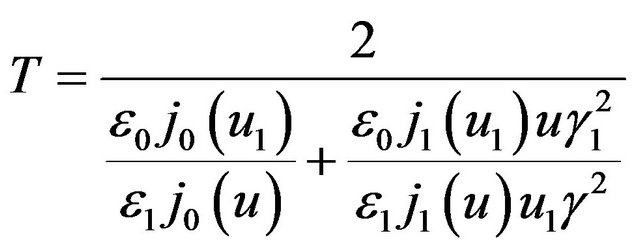 (28)
(28)
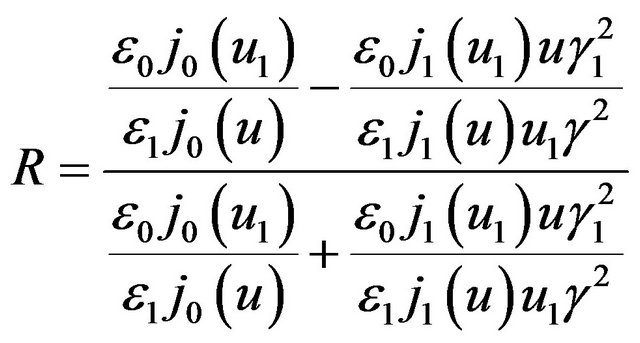 (29)
(29)
The scattered wave in spectral denotes can be found by subtitling (28) and (29) for lossy ground, the space domain scattered waves can be calculated numerically by inverse Fourier transform
 (30)
(30)
Efficient numerical evaluation of the inverse Fourier integral (30) plays an important role in integral increasing an the final solution of the transient problem in space domain and the transient spectral domain method is used to analysies electromagnetic radiation from an impulsive vertical magnertic dipole above conductive half space and the reflected field and refracted field are radiation of original source in homogenous unbounded media.
2. Conclusion
The transient spectral domain method is presented as a versatile procedure for transient analyzes of point source radiation near two layered media in spherical domain. This procedure leads to a new transient representation of electric under potential in air and ground regions in spectral domain; also it is a simplified to close-form spectral representations when the ground medium is assumed to be lossless.
REFERENCES
- J. R. Wait, “Electromagnetic Waves in Stratified Media,” Pergamon Press, Oxford, 1970.
- A. Sommerfeld, “Uber die Ausbreitnng der Wellen in der Drahtlosen Telegraohie,” Annalen der Physik, Vol. 333, No. 4, 1909, pp. 665-736. doi:10.1002/andp.19093330402
- H. Weyl, “Ausbrieiting Electromagnetischer Wellon uiber Einium Ebenen Letier,” Annalen der Physik (Leipzig), Vol. 13, 1919, pp. 481-500.
- A. Banons, “Dipole Radiation in the Presence of a Conduting Half-Space,” Pergamon Press, New York, 1966.
- I. V. Lindell and E. Alanen, “Exact Image Theory for the Sommerfeled Half-Space Problem, Part II. Vertical Electric Dipole,” IEEE Transactions on Antennas and Propagation, 1984, pp. 2758-2761.
- S. I. Dvorak and M. M. Mechaik, “Application of the Contour Transformation Method of a Vertical Electric Dipole over Earth,” Radio Science Journal, Vol. 28, No. 3, 1993, pp. 309-307.
- L. Cagniard, “Reflexion et Refraction des Ondes Seismiques Progressive Cambridge,” Gauther-Villard, Cambridge, 1939.
- A. A. Abo-Seliem, “The Transient Response above an Evaporation Duct,” Journal of Physics D: Applied Physics, Vol. 31, 1998, pp. 3046-3050. doi:10.1088/0022-3727/31/21/010
- A. A. Abo-Seliem, “Transient Electromagnetic Field of a Dielectric Layer,” Applied Mathematics and Computation, Vol. 157, No. 3, 2004, pp. 759-764. doi:10.1016/j.amc.2003.08.118
- J. A. Stratton, “Electromagnetic Theory,” McGraww-Hill, 1941.

